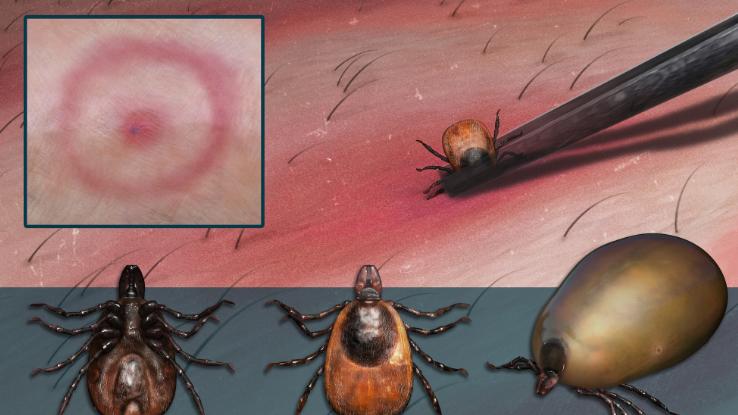Lyme Disease 101: From Tick Bites to Neurological Problems

Taking its name from the coastal town of Lyme, Connecticut, Lyme disease is the most common tick-borne disease in the United States. So, what exactly causes Lyme disease? In short, the bacterium Borrelia burgdorferi, which is transmitted through tick bites, causes Lyme disease.
While the bacterium can be transmitted by several species of tick, the biggest culprit is the black-legged deer tick. In order for an infection of Lyme disease to occur, the tick must remain attached to an individual for at least 36 to 48 hours. However, other tick-borne infections can occur in a shorter amount of time. In fact, individuals who come down with Lyme disease can also be infected with other tick-borne diseases and conditions, such as Ehrlichiosis and Babesiosis, from the same bite.
The vast majority of cases occur during the warm spring and summer months, with 94% of all cases occurring in the following 12 states:
- Connecticut
- Delaware
- Maine
- Maryland
- Massachusetts
- Minnesota
- New Jersey
- New Hampshire
- New York
- Pennsylvania
- Virginia
- Wisconsin
It should also be noted that cases occur frequently in the northern, forested region of California.
The Three Stages of Lyme Disease
Stage One
- This stage occurs within a few weeks of the tick bite. At this stage, the effects of the infection are localized to the area surrounding the bite and include reddening and the development of the infamous bull’s eye-shaped rash. The individual may also experience general flu-like symptoms.
Stage Two
- The intermediate stage occurs within the first months after infection. At this stage, the infection has spread and might cause multiple skin lesions. It can also cause problems with the cardiac and neurological systems — though this only occurs in a low percent of cases.
Stage Three
- This final stage occurs several months to a year after the initial infection. At this stage, the infection is widespread and may cause pain as well as neurological problems, including dementia. Lyme disease can still be treated at this stage, but the person will likely have some lasting effects.

Symptoms Associated With Lyme Disease
Lyme disease symptoms vary based upon the stage of the infection. In the beginning, it can be easy to mistake the symptoms as something as simple as the flu.
In stage one, symptoms may come and go, and include:
- Headache
- Lightheadedness or fainting
- Fever
- Chills
- Stiff neck
- Muscle aches
- Itching all over the body
- Malaise, or a general feeling of being unwell
One of the most well-known symptoms associated with Lyme disease is tell-tale rash, also called Erythema Migrans. Although well-known, this bull’s eye-shaped rash occurs in just 80% of cases of Lyme disease. Often, it will spread outward from the bite and can vary in size.
In stage two, symptoms may include:
- Muscle pain or joint paint
- Swelling in joints
- Paralysis or weakness in the face
- Heart problems, such as palpitations
- Pain in the legs, especially in the night
- Headaches
Finally, symptoms associated with stage three include:
- Speech problems
- Joint and muscle pain
- Muscle weakness
- Abnormal muscle movements
- Numbness and tingling
- Causes & Risk Factors Associated With Lyme Disease
As mentioned above, Lyme disease is caused exclusively by the bite of an infected tick. Most often, the ticks live in wooded and brushy areas. If you walk through their habitat — or if your pet does — the ticks may latch onto you, often migrating toward the warmer areas of the bodies to feed.
Of course, not everyone who is bitten by a tick will get Lyme disease, but it’s best to be cautious if you find a tick on your body, clothes or pet. Be sure to thoroughly check your body for ticks after:
- Participating in outdoor activities such as gardening, hunting, or hiking in areas where ticks are known to inhabit
- Letting house pets explore areas where ticks reside
- Walking in areas with high grass, such as fields
Diagnosing Lyme Disease
Diagnosing Lyme disease can be challenging, namely because patients don’t always notice their tick bite. Since the symptoms can be similar to the flu and other illnesses, missing a tick bite can lead to a misdiagnosis.
If you suspect you’ve experienced a tick bite, be sure to monitor your symptoms and inform your doctor. Additionally, it’s helpful to document where your tick bite was and if you noticed any swelling or redness. Based on your symptoms, your doctor will conduct a series of tests to diagnose your condition and prescribe the most effective treatment.
- Physical Examination: Depending on your symptoms, your doctor may examine you to determine any abnormalities from rashes to joint swelling and neurological abnormalities. Depending on your symptoms, you will likely need additional follow-up tests. These physical examinations are preliminary and cannot conclusively diagnose Lyme disease — with one exception. If you develop the Erythema Migrans — that bull’s eye-shaped rash that spreads outward from the bite — your doctor can confirm your diagnosis without further tests.
- Blood Test: A blood test can help diagnose Lyme disease in all three stages.
Treatment & Prevention
When it comes to prevention, the best thing you can do is remain aware. If you hike or walk in an area inhabited by ticks you should:
- Wear protective clothing that has been treated with tick repellent
- Avoid wooded or grassy areas that have a high amount of leaf debris
- Walk in the center of trials
- Conduct a full-body tick check at least once a day. Look in areas such as armpits, navels, groin, between legs, in the hair, and in and around the ears
- Check your gear and pets for ticks Note: Pets should receive regular tick prevention regimens. Contact your vet for more information.
If caught early, treating Lyme disease is also fairly simple. The most common antibiotic used in treating a Lyme disease infection is doxycycline. However, some people can’t take this antibiotic, so amoxicillin or cefuroxime can be used instead, so long as the dosage is higher and the treatment is longer in duration.
Other treatment options will depend upon the severity of the infection. For instance, cardiac problems may be treated separately from the infection itself.
Complications Associated With Lyme Disease
Over time, if left untreated, symptoms can become severe and lead to problems with the heart, neurological system, muscles, and joints.
Moreover, there is a phenomenon called post-Lyme disease syndrome, which is currently being investigated by researchers. Although little is known about post-Lyme disease syndrome, individuals find that symptoms can be chronic and impact their day-to-day lives even if they were treated for Lyme disease when symptoms first occurred.
With this in mind, treating Lyme disease early is essential for a full recovery. If you notice a tick on your body, remove it immediately — and properly. Even if you don’t see a tick, but find an unusual bite or experience symptoms of Lyme disease after venturing into a grassy or wooded area, seek medical attention immediately to ensure you receive proper treatment.
Resource Links:
- “Lyme borreliosis: diagnosis and management” via BMJ
- “Lyme borreliosis” via Nature
- “Review of European and American guidelines for the diagnosis of Lyme borreliosis” via ScienceDirect
- “Lyme disease: A rigorous review of diagnostic criteria and treatment” via ScienceDirect
- “Diagnosis, Treatment, and Prevention of Lyme Disease, Human Granulocytic Anaplasmosis, and Babesiosis” via JAMA Network
- “Lyme Disease — Connecticut” via Centers for Disease Control and Prevention (CDC)
- “Tick Removal” via Centers for Disease Control and Prevention (CDC)





